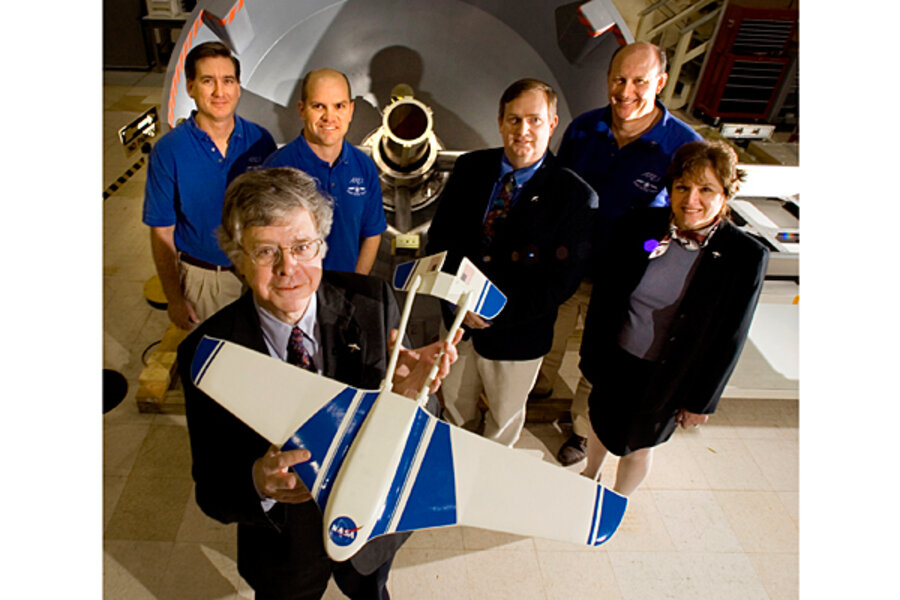Should we explore Mars with a robot airplane?
Loading...
Various orbiters, landers and rovers that have explored Mars in the past three decades have revealed tantalizing evidence of the conditions for life, from frozen water at the planet’s North Pole to methane plumes in the atmosphere. For atmospheric scientist Joel Levine, the evidence has made the case for flying an airplane over Mars stronger than ever.
Levine champions the ARES Mars airplane mission at NASA’s Langley Research Center in Hampton, Va. He believes that a robotic, rocket-powered airplane is the perfect platform for unraveling the Red Planet’s biggest mysteries.
Soaring at an altitude of 1.6 kilometers, an airplane could cover hundreds of kilometers, gathering visual images and remote sensing data that it transmits back to Earth. [Photo of the Mars airplane ARES]
"A powered airplane flying a mile above the surface can obtain measurements over inaccessible parts of Mars and collect a whole bunch of data that no rover can collect," Levine said. As opposed to orbiters, meanwhile, the airplane would be close enough to the ground to get high-resolution images and chemical sensing data.
Airplanes on Mars
ARES, which stands for Aerial Regional-Scale Environmental Surveyor, is Levine’s brainchild. He has now formed a team of 250 people, from airplane designers to mission planners to bring his vision of a robotic airplane soaring above Mars to fruition. The team has built and tested a prototype ARES airplane and they are gearing for the next NASA Mars mission solicitation.
The ARES airplane prototype is 16.4 feet (5 meters) long, with a wingspan of about 21 feet (6.5 meters), and is made of a lightweight polymer-carbon composite material. It would be packed with its tail and wings folded into an aeroshell similar to the one that brought the rovers to Mars.
About 12 hours away from the surface, the carrier spacecraft would release the aeroshell, which would descend to the surface aided by a parachute. Thirty-two kilometers above the surface, the airplane would be ejected, its wings and tail would unfold and the rocket engines would ignite.
Levine is most interested in flying ARES over the mountains, craters and volcanoes in the southern highlands, where it hasn’t been possible to land safely until now.
"There are some very interesting things in the southern hemisphere," Levine said. "There are regions of very high crustal magnetism, whose origin no one understands. By studying crustal magnetism, we can learn whether it will shield the surface of Mars from high-energy solar wind particles. This will help us learn more about radiation that humans on the surface will experience."
Soaring over the Red Planet
ARES would take samples of the Martian atmosphere every three minutes, helping to pinpoint the exact source of the methane plumes that have been discovered on the planet — methane on Earth is produced by living systems, but its point of origin on Mars remains a mystery.
Equipped with the right instruments, the airplane also could study subsurface water and probe the ground for telltale signatures of life.
Levine first got involved with Mars airplanes in 1999. NASA’s administrator at that time, Dan Goldin, had announced a competition between various NASA centers to put a lightweight, low-cost airplane on Mars.
The plan was to piggyback the chosen craft aboard an Ariane rocket launched by the French space agency CNES. The airplane flight through the Martian atmosphere was to take place on Dec. 17, 2003 to commemorate the centennial of the Wright brothers' first powered flight.
NASA chose the Langley Research Center team to lead the effort, with Levine as the project scientist for the mission. The project was cancelled later that year for budgetary reasons, but he has since been convinced that an airplane was the way to go for Mars exploration.
Levine believes airplanes could offer an affordable and reliable way to explore Mars. Missions such as the upcoming Mars Science Laboratory, slated for 2011, may be more difficult from a technological standpoint, he said. [6 Facts About the Mars Science Laboratory]
"An airplane is deployed in the atmosphere," he said, "so you don’t have to worry about landing on rough terrain or retro-rockets and firing at precise times."
Aerial Martian recon
Airplanes would be ideal for observing large regions at close range, said Charles Whetsel, manager of the advanced studies and program architecture office at NASA’s Mars Exploration Directorate.
To date, however, he says Mars exploration has been conducted with orbiters, landers and rovers, because they typically have long lifetimes of months to years.
Indeed, Levine says ARES’ fuel would only last for a two-hour flight. But in that time it could cover close to 932 miles (1,500 km), and after its fuel is depleted, the airplane should be able to land on the ground and continue making measurements.
Besides, he stressed, airplanes would be the most reliable way to observe the planet’s rugged southern region where a rover would find it difficult if not impossible to drive.
The Langley team has successfully tested deployment and flight in the Earth’s atmosphere at a balloon facility in Tillamook, Oregon, using a half-scale ARES model. They have folded and packed the airplane into a shell and deployed from a helium balloon 18.6 miles (30 km) above ground.
The researchers also have done a series of wind tunnel tests to validate their predictions on how ARES would fly in the Martian atmosphere.
The ARES technology is proven on Earth, says Levine, and he is confident that a Mars mission should happen within the next decade. In fact, ARES was one of four finalists for the NASA Mars Scout mission in 2002 before the Phoenix mission was chosen.
"I feel scientifically we have a unique platform and experiment," he said. "ARES is only the first step."


